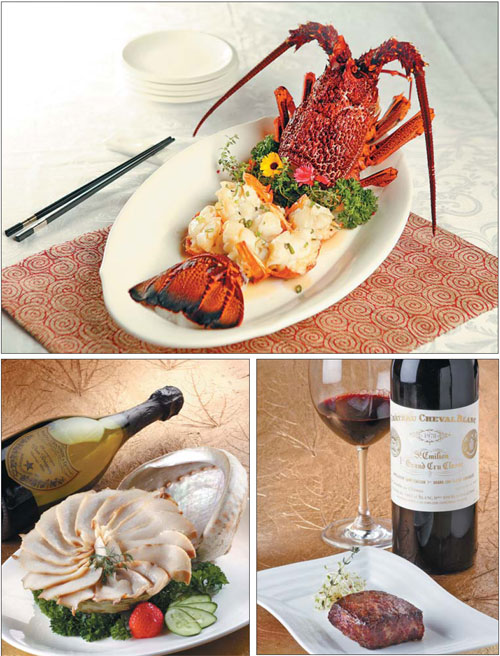Imperial treasures lure natives of Shanghai back to the Bund
|
Baked lobster with supreme gravy (top), sliced cold abalone (above left) and grilled beef (above right) highlight the menu of Singapore Restaurant Group's new branch in Shanghai. Photos provided to China Daily |
Iconic Shanghai landmark The Bund is often avoided by the city's locals looking to dine.
Shanghai residents proudly present The Bund as a cultural mix of East and West, an architectural tribute to modern sophistication and the city's rich history, but when it comes to eating, the shrewd natives delve deep into the zigzag paths behind the historic street to seek out restaurants they consider better value for money.
"The restaurants on the Bund don't sell food, but the view, to tourists and rich people," locals tell their visiting relatives and friends, as if passing on a local secret.
But Imperial Treasure, a new addition to the galaxy of fine dining restaurants on the Bund, might be an exception.
The Cantonese restaurant is the first branch opened by the Singapore Restaurant Group outside its own country, and has quickly become one of the favorite dining rooms for Shanghai residents to celebrate special occasions. It not only boasts a grand 2,000-square-meter space, but also offers an exquisite collection of Cantonese dim sum, siew mai and seafood.
The most popular dishes at this restaurant are steamed custard buns and steamed shrimp dumping. The former is nothing special but it is true to its Chinese name - "golden-sand-flowing bun". The bun must be eaten quickly so the "golden sand" doesn't flow all over, on your hand, the plate, even your clothes.
The steamed shrimp dumpling is much easier to handle, but boasts an equally rich filling. Aside from the tender tips of bamboo shoots, the dumping is full of large fresh shrimps.
The Peking duck, on the other hand, is not as authentic as it is in its hometown, but has an "exotic" flavor. The ducks used to come from the Yangtze River, and are different from the ones used in Beijing, and provide a much more tender and juicy meat. The steamed pancake, handmade by the dim sum chefs who are very good with flour, are more moist and glutinous than in the capital. Ninety slices of skin are carved from each duck, according to the restaurant, and every day, there are six ducks available.
If you are going for something fancy or high-end, the restaurant also offers a variety of delicacies including shark's fin, bird's nest and abalone, cooked with the creme de la creme of ingredients by the experienced chefs. The chilled abalone sashimi, for example, uses the freshest abalone imported from the pristine coast of Australia. It is lightly cooked and put aside to cool, then sliced at a strictly standard thickness, served to diners with barely any sauce.
The best of the best, however, does not come cheap, with prices ranging from 68 yuan ($11) for a dish of chilled abalone, to the 550 yuan per person "all-inclusive", which includes braised sliced abalone, sea cucumber, fish maw and supreme seafood, to the 3,888 yuan braised six-head dried Japan abalone, for advance orders only.



















